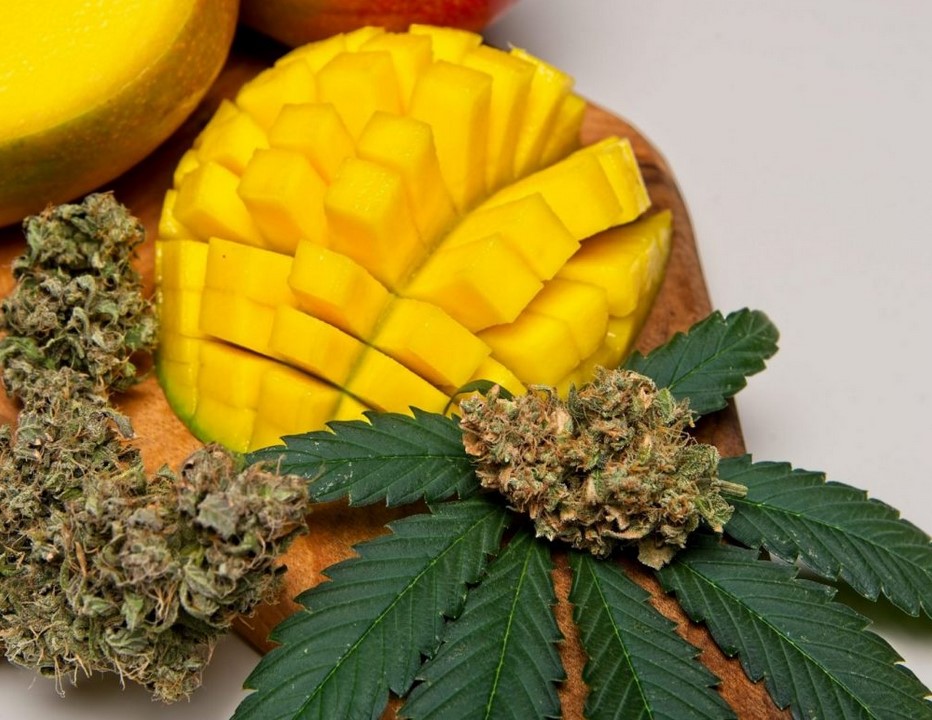Terpenes are aromatic hydrocarbons that may be found in the essential oils of all plants and have been used in medicine for thousands of years. Terpenes are now well-known for being the chemicals responsible for each cannabis strain’s unique aroma and flavor, but it was only recently proven that they can influence the plant’s efficacy.

The entourage effect states that cannabis’ active components may benefit more from working together than they do alone. Terpenes play a crucial role in this. Plants release terpenes as a defensive measure against insects and illnesses in order to protect themselves. They are responsible for the unique scents and tastes of each species. Terpenes also have an impact on human physiology by affecting numerous processes.
Terpenes are a class of chemical found in cannabis plants that contribute to its distinctive aroma and taste. Terpenes can be found in a variety of plants, but they are particularly common in marijuana. The most abundant cannabis terpene is myrcene, which we’ll look at in this post.
About Myrcene
The most common and highly active terpene in cannabis is myrcene (also known as alpha-myrcene or beta-myrcene), which has a pungent, earthy, musky flavor that gives cannabis strains a somewhat sweet taste profile.
Isopropyl myrcene is also present in plants such as lemongrass, eucalyptus, and ylang-ylang, as well as fruits such as mangos (have you heard the claim that they can boost your high? It’s true) and herbs including thyme, basil, and hops (the one that gives beer its flavor). Cannabis, on the other hand, is by far the most plentiful source of myrcene.
Myrcene is a terpene that can help to relax the body and mind. Indica-dominant strains with myrcene levels above 0.5 percent induce the euphorically named “couch lock,” a state of profound relaxation induced by Indica-dominant strains. In fact, myrcene may account for up to 50% of total terpenes in a cannabis plant. Sativa-dominant plants, on the other hand, are known to have less than 0%.
Medicinal Efficacy
The endocannabinoid system (ECS) and terpenes have a lot in common. The major goal of myrcene is to put you to sleep, resulting in limber muscles and pain relief. This has obvious value in a variety of circumstances, including spasticity, seizure activity, or hyperactivity (including ADHD), as well as common and often severe illnesses such as fibromyalgia and Post Traumatic Stress Disorder (PTSD).
“The current data and findings” back up the theory that myrcene is a significant sedative terpene in cannabis, as well as — when combined with THC — may produce the “couch-lock” effect of certain chemotypes praised or despised by recreational users.
Essential oils are rich in myrcene. According to Leafly, “Pair this notoriously anti-inflammatory terpene with herbal cocktails containing lemongrass or hops for a powerful calm that may put those numbered sheep to rest.” It’s been found in studies to help people suffering from sleeplessness, restlessness, and a range of other conditions including anxiety. “This especially anti-inflammatory terpene can be mixed with herbals containing lemongrass or hops for a strong sedative that may put those numbered sheep to sleep,” according on Leafly.
Myrcene has antiseizure and antidepressant effects, as well as anti-inflammatory properties. Myrcene performs the same function as limonene, which is to modify cell membrane permeability. It works as a moderator of other terpenes and cannabinoids, increasing or lowering their impact and strength (much like CBD does with THC).
Myrcene is a unique chemical component in cannabis that has the capacity to enhance the number of THC molecules that reach CB1 receptors in the brain and central nervous system, resulting in an enhanced psychoactive effect as well as better medical efficacy. In this sense, myrcene is a great illustration of the entourage effect.
“It’s a wonderful illustration of the entourage effect, in which both terpenes and cannabinoids collaborate synergistically to provide or enhance a certain therapeutic advantage that can’t be obtained from any one cannabinoid or terpene alone,” wrote Dr. Ethan Russo, a research scientist and board member of the International Cannabis Research Program.
Myrcene has a soothing effect, which is why it’s frequently used as a sedative. It also includes antineoplastic, antibacterial, antioxidant, and antiseptic properties. Myrcene can help to relax muscles and so may be of use in neurological conditions such as dystonia, epilepsy, and Parkinson’s disease. The anti-anxiety effects of myrcene are thought to be therapeutic in the treatment of mental disorders.
Myrcene Benefits

Myrcene has antioxidant benefits that can help protect cells from oxidative damage and extend their lifespan. Furthermore, studies on myrcene’s effects indicate that it may have its own important functions. Although there is still much to learn about terpenes and myrcene, here’s what we know so far.
Sedative Effects
The relaxing, sedative effects of myrcene are well-known. In a 2002 study published in the journal Phytomedicine, researchers investigated the impact of myrcene on mice. At higher dosages, myrcene had an antiactivatory effect on mice, making them less interested in exploring the open arms in an elevated plus-maze test. It also boosted sleeping duration by more than 160%.
For anybody suffering from stress or sleeplessness, the early findings of this study are encouraging. High-myrcene cannabis strains may help people get a good night’s sleep by providing strong sedation.
Anti-inflammatory Effects
Myrcene has also been found to help with inflammation reduction. The majority of individuals link inflammation with malignant illnesses such as arthritis. It’s been linked to a slew of other diseases, including heart disease, strokes, diabetes, and cancer.
A 2015 study published in the European Journal of Pharmacology looked at the effects of myrcene on inflammation in osteoarthritis. Human chondrocytes (cartilage cells) were given myrcene, and the results showed that it reduced inflammation and catabolic activity. The authors concluded that myrcene might help protect cartilage from damage by slowing or even stopping cartilage deterioration.
Consider a high myrcene strain if you’re searching for a pain medication that works. CBD has powerful anti-inflammatory properties, so consider selecting a CBD-rich variety to potentially enhance its effects.
Analgesic Effects
Myrcene might be beneficial in the treatment of pain, according to a study published in the Journal of Pharmacy and Pharmacology in 1990. The analgesic effects of myrcene were examined using a hot plate method and an acetic acid-induced writhing test on mice in this research. Myrcene inhibited nociception, suggesting that it has anti-inflammatory properties.
The myrcene effect was blocked by naloxone, implying that this terpene has an impact on the body’s endogenous opioids. These natural chemicals are produced naturally in the body as a result of pain. They function similarly to opiates like morphine in that they provide euphoric effects and have less severe side effects.
Mucuna pruriens contains myrcene, which may help with a variety of pain symptoms. This might make high-myrcene strains beneficial for sufferers of severe pains as well as its sedative and anti-inflammatory effects.
Potential Risks: Does Myrcene Cause Cancer?
Despite the fact that myrcene has a variety of health advantages, some researchers believe it to be linked to an increased cancer risk. A study published in 2010 by the National Toxicology Program revealed that high doses of myrcene caused tumorgenicity in rats. According to the research, male rats with high amounts of myrcene had a higher incidence of kidney and liver cancer.
Despite these worries, there is presently no evidence that myrcene causes cancer in humans. However, in light of the research, the Food and Drug Administration (FDA) removed it from its list of permitted additives two years ago.
There is some doubt whether myrcene should be classed as a cancer-causing substance or not. It’s impossible to say how safe myrcene is until further research is done. The FDA, on the other hand, has made it clear that its revised guidelines apply to manufactured rather than natural items containing it. Whether naturally occurring myrcene has the same effects is unknown.
High Myrcene Cannabis Strains
Indicas are the most common strain of cannabis with a high myrcene content. This is to be expected, given that many people look for indicas for their sedative and pain-relieving effects.
The following are some of the most well-known high myrcene marijuana strains:
- OG Kush
- Skywalker OG
- Blue Dream
- Remedy
- 9 Pound Hammer
- Grape Ape
- Granddaddy Purple
- Girl Scout Cookies
- Thin Mint GSC
- Tangie
While not powerful enough by themselves, these strains might be used in conjunction with other cannabis plants to alleviate pain and inflammation. Because they may make you sleepy,
Other Sources of Myrcene
Myrcene is a chemical component found in marijuana and other herbs, spices, fruits, and vegetables. The following are some of the most frequent myrcene sources:
- Hops
- Lemongrass
- Thyme
- Bay
- Basil
- Verbena
- Carrots
- Pomegranate
- Mango
What science says about myrcene
Myrcene has been the focus of scientific study for some time, and it’s one of the terpenes that gets a lot of attention when it comes to medical applications. Researchers in Brazil found that myrcene behaved similarly to lemongrass tea, which is used in some traditional medicine systems as a mild sedative. It’s also regarded to have anesthetic qualities, and it’s critical for minty-flavored menthol cigarettes to be made.
Myrcene has been shown in studies to help people with migraines. Myrcene, along with linalool and eucalyptol (both of which are terpenes found in cannabis), was discovered in one 2008 study to assist prevent human cells from neurotoxins that might cause genetic damage that leads to cancer.
Final Thoughts
Myrcene is a cannabinoid that has a number of health advantages. It has sedative and relaxing properties, which may aid with inflammation and pain alleviation. People suffering from tension, sleeplessness, or painful issues might benefit from strains high in myrcene. Choose an indica or hybrid strain with strong indica roots if you’re looking for a high myrcene strain.
Cannabis high in myrcene, on the other hand, is best consumed later in the day. Otherwise, it might make you so tired that you fall asleep on the sofa.
Several scientists have indicated that myrcene causes cancer in rats. There is no evidence, however, that this occurs in humans. We propose that concerned individuals read the study and decide whether the benefits outweigh the risks for them.
